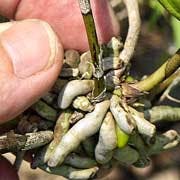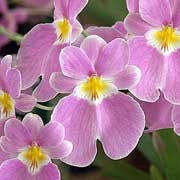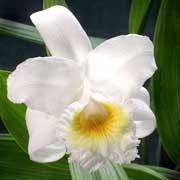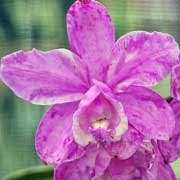V
vagans (VAY-ganz) Of wide distribution; wandering.
vaginatus, -a, -um (vaj-i-NAY-tus) Having sheaths; vaginate.
valid publication (VAL-id) Publication in accordance with the rules of the International Codes of Nomenclature.
validus, -a, -um (VAL-id-us) Strong; well-developed.
vallecula (vuh-LEK-yuh-luh) Said of grooves between ridges.
valvate (VAL-vayt) Opening by valves or pertaining to valves; meeting at the edges without overlapping, as leaves or petals in the bud.
valve (valv) A separable part of a pod; the units or pieces into which a capsule slits or divides in dehiscing.
Vanda (VAN-da) A genus of about 50 showy epiphytic orchids of monopodial habit found in the Asiatic tropics, it was described by Jones in 1795, the name being derived from the Sanskrit for the orchid Vanda tessellata.
vandaceous (van-DAY-shuss) An adjective referring to any large monopodial orchid, usually restricted to Asiatic genera with the parallel term angraecoid applying to African plants.
Vandopsis (van-DOP-siss) A genus of five species of vandaceous orchids, distributed from Myanmar and Thailand to the Philippines and New Guinea, closely allied to Sarcanthopsis and Trichoglottis, it was described in 1889 by Pfitzer, the name implying a resemblance to Vanda.
Vanilla (va-NIL-la) A genus of 100 species of vinelike orchids, widely distributed in the tropics and subtropics of both hemispheres, it is related to Epistephium; described in 1799 by Swartz, the name is derived from the Spanish vainilla, meaning "little pod," and refers to the slender podlike fruit.
variabilis, -e (vair-ee-AY-bil-liss) Varying in form or color; variable.
variegatus, -a, -um (vair-ee-GAY-tus) Irregularly colored in patches; blotched; variegated.
varietal (vuh-RYE-eh-tuhl) Of or pertaining to a variety; having the character of a variety or subspecies.
variety:
Cattleya gaskelliana variety (abbreviated: var.) alba has white flowers instead of the typical lavender-pink color.

variety (vuh-RYE-eh-tee) A subset of the population having minor characteristics which distinguish it from the type of the species. (For horticultural variety, see cultivar)
vascular (VAS-kewl-er) Pertaining to, composed, of, or provided with vessels or ducts which convey fluids such as water and sap.
vegetative (VEJ-i-tay-tiv) That part of the plant, such as the stem and leaves, not directly concerned with reproduction.
vegetative propagation (VEJ-i-tay-tiv prah-pah-GAY-shun) The increasing of a plant population through cuttings, divisions, bud stimulation, protocorm proliferation, and various techniques of tissue culture.
vegetus, -a, -um (VEJ-et-us) Lively; vigorous.
vein (vayn) A strand of fibro-vascular tissue (vascular bundle) in a leaf or other organ through which water and other fluids are conducted.
velamen:
Velamane is the sponge-like
covering of orchid roots.

velamen (VEL-lah-min) The layer or layers of cells covering the roots of epiphytic orchid which aid in the rapid absorption and assimilation of water and mineral nutrients.
velamentous (vel-ah-MEN-tus) Resembling or having a velamen.
velaris, -e (vel-AY-riss) Pertaining to a veil.
velatus, -a, -um (vel-LAY-tus) Veiled.
velox (VEE-loks) Quick-growing.
velutinus, -a, -um (vel-YEW-tin-us) Velvety; soft; velutinous.
venosus, -a, -um (vee-NOH-sus) Veined; having many or prominent veins; venous; venose.
ventral (VEN-trahl) Referring to the lower surface of an organ such as a leaf; that surface that faces the center or axis of a flower; opposite of dorsal.
ventricosus, -a, -um (ven-tri-KOH-sus) Distended; swelling, especially on one side; unevenly inflated; ventricous; ventricose.
venustus, -a, -um (vee-NOOS-tus) Comely; graceful; ladylike; charming.
veratrifolius, -a, -um (veh-rat-tri-FOH-lee-us) Having leaves like Veratrum nigrum, the black hellebore.
verecundus, -a, -um (veh-re-KUN-dus) Modest, shy, coy; blushing; verecund.
vermiculite (ver-MIH-cuhl-ite) A heat-expanded mica sometimes used to provide aeration in orchid-potting media.
vernal (VER-nuhl) Appearing in the spring.
vernalis, -e (ver-NAY-liss) Of the spring; spring-flowering; vernal.
vernation (ver-NAY-shun) The disposition or arrangement of leaves within the bud.
vernicosus, -a, -um (ver-ni-KOH-sus) Shiny, as though varnished; vernicose.
verrucosus, -a, -um (ver-rew-KOH-sus) Covered with wartlike elevations or excrescences; verrucose.
versicolor (VER-si-kul-er) Changeable in color; variously colored; versicolor.
verticil (VER-ti-sill) A circle of foliar organs, flowers or inflorescences about the same point on the axis; a whorl.
verticillastrate (VER-ti-sill-a-strayt) Said of leaves arranged in a group resembling a whorl.
verticillatus, -a, -um (ver-tis-sil-LAY-tus) Arranged in a whorl, like the spokes of a wheel; verticillate.
verus, -a, -um (VEE-rus) True; genuine; true to type; standard.
vesicle (VESS-i-kul) A small bladder or air-cavity.
vescus, -a, -um (VESS-kus) Thin; feeble; gross-feeding.
vespertinus, -a, -um (ves-per-TYE-nus) Of the evening; evening-blooming.
vestalis, -e (ves-TAY-liss) Virgin-like; chaste; vestal.
vestigial (ves-TIJ-ee-al) Rudimentary; imperfectly developed or underdeveloped.
vestitus, -a, -um (ves-TYE-tus) Clothed with soft hairs; covered.
vexillaris, -e (vek-sill-AY-riss) Showy, like a banner or vexillum, the flag carried by an ancient Roman soldiers.
vexillaria:
Miltoniopsis vexillaria has showy flowers, like a banner.

vexillarius, -a, -um (vek-sil-LAY-ree-us) Bearing a flag or banner; a standard-bearer.
viability (vye-a-BILL-ih-tee) The capability of survival.
viable (VYE-a-buhl) Capable of survival and development, as the germination of seed.
viatical (VYE-at-ih-kuhl) Said of plants growing by paths or streams.
villosus, -a, -um (vill-OH-sus) Shaggy; clothed with long, soft hairs; villous; villose.
vinosus, -a, -um (vye-NOH-sus) Wine-red in color.
violaceus, -a, -um (vye-oh-LAY-see-us). Violet-colored; violaceous.
violescens (vye-oh-LESS-enz) Almost violet-colored; turning violet.
virens (VYE-renz). Fresh-looking; lively green.
virescens (vih-REH-senz). Light green; having a tendency to turn green.
virgatus, -a, -um (ver-GAY-tus). Rodlike; long, slender, and straight; twiggy; virgate.
virginalis:
Sobralia virginalis has pristine white flowers.

virginalis, -e (ver-jin-AY-liss). Maidenly; pure white; virginal.
viridescens (veer-i-DESS-enz). Becoming green.
viridipurpureus, -a, -um (vi-rid-i-purr-PURR-ee-us). Greenish purple.
viridiflorus, -a, -um (vi-rid-i-FLOR-us). With green flowers; green-flowered.
viridis, -e (VEER-i-diss). Green.
virus (VYE-russ) An infective or disease-producing parasitic agent smaller than common microorganisms and requiring living cells for multiplication.
virus:
Cattleya loddigesii flower exhibiting color break typical of a virus infected plant.

viscid (VISS-id). Sticky; glutinous.
viscidium (vi-SID-ee-um). The portion of a rostellum that affixes the pollinarium to a pollinator.
vitellinus, -a, -um (vye-tell-LYE-nus). The color of an egg yolk; vitelline.
vittatus, -a, -um (vit-TAY-tus). Banded; marked with longitudinal stripes; also, provided with a vitta or vittae; vittate.
viviparous (vye-VIP-a-ruhs). Growing or sprouting on the parent plant.
volute (VOH-lewt) Rolled.
volutus, -a, -um (voh-LOO-tus). Rolled up like a scroll; having rolled leaves; volute.
volubilis, -e (vol-YEW-bil-iss). Twining; rolling; turning.
vulcanicus, -a, -um (vul-KAN-ik-us). Growing on the sides of a volcano.
vulgaris, -e (vul-GARE-iss). Common; ordinary.
Vuylstekeara (vowl-schtayk-ee-AH-rah). A former hybrid genus derived from Cochlioda, Miltonia and Odontoglossum created in 1912 and named in honor of C. Vuylsteke, an orchid hybridizer. With the reordering of the Onciidinae most of these hybrids are now called Oncidopsis.









